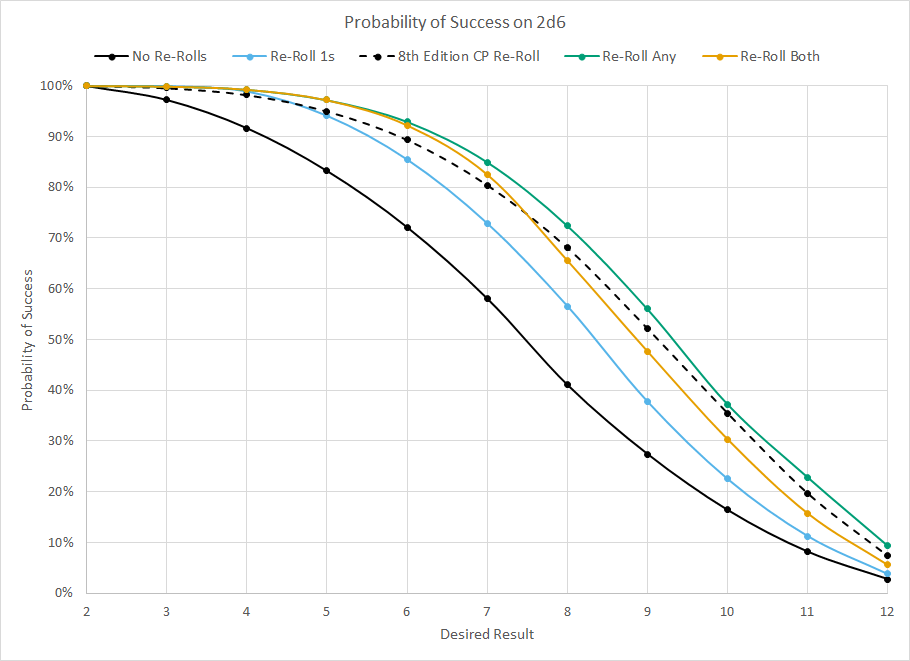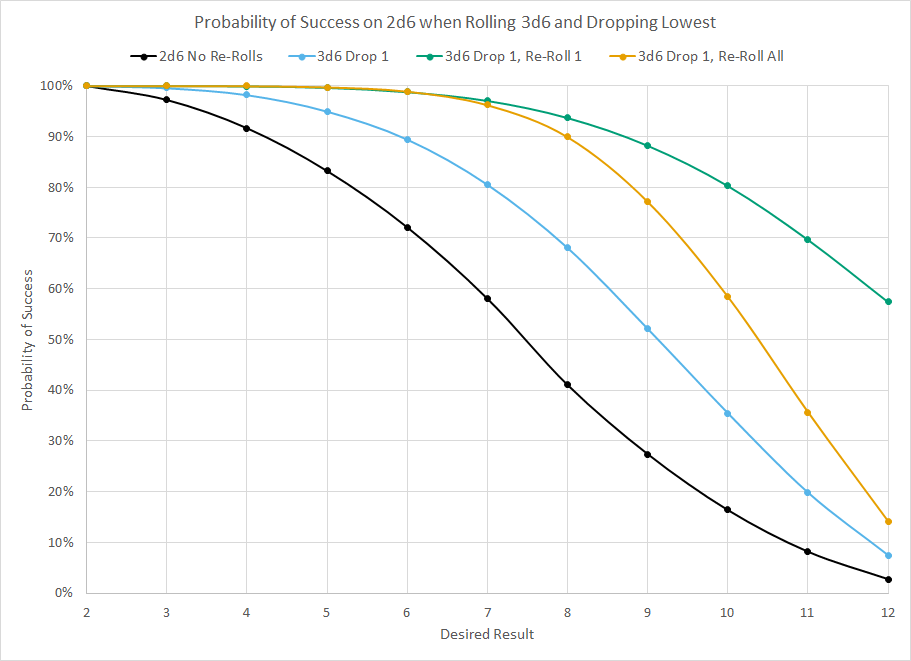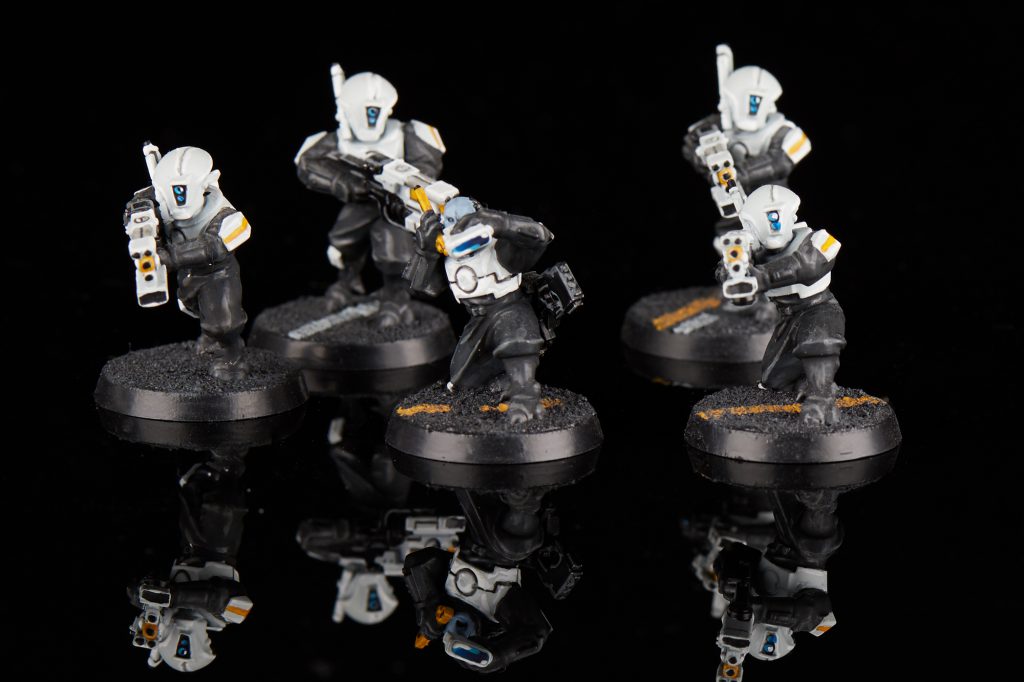Greetings everyone! With 9th Edition just one week away from pre-order and the media blackout lifted, we can talk about all of the cool and interesting details that will be different in 9th Edition. As always Hammer of Math is here to take a deeper look into the probabilities and math behind those changes. This week we’re going to look at one of the biggest; the change to the Command Re-roll Stratagem.
The Command Re-roll Stratagem has been one of the core elements of Warhammer 40,000 since the beginning of 8th Edition. Early on, when players had limited access to Stratagems during the Index days, it was often the best (if not only) option. Multiple army books and updates later and it remains a useful tool. The rules were very simple; for a single Command Point you could re-roll any single dice. Regardless of whether that dice roll was for a Psychic test, charge roll, hit roll, armor save, or anything else, you could re-roll it. The fact that it was re-rolling a single dice instead of the entire roll provided a significant improvement in probability and was invaluable for charge rolls in particular.
Unfortunately, that time is past.

The rules for Command Re-roll have changed significantly:
Use this Stratagem after you have made a hit roll, a wound roll, a damage roll, a saving throw, an Advance roll, a charge roll, a Psychic test, a Deny the Witch test, or you have rolled the dice to determine the number of attacks made by a weapon. Re-roll that roll, test, or saving throw.
What was once a dramatically open and highly flexible means of changing the outcome of the game is now heavily constrained. Instead of being any roll you are now limited to only those nine conditions which are carefully defined in the Appendix. Things like the number of mortal wounds dealt by a Stratagem or Psychic power, dice rolls for abilities that Ignore Wounds, or oddball abilities or results like Chaos Boon Stratagem can no longer be affected. The requirement that the entire roll, test, or saving throw be re-rolled is also significant. Previously a roll of a 1 and a 6 could be re-rolled with a high probability of getting an exceptional result. That is no longer the case, and instead you are entirely at the mercy of the law of averages.
2d6 Tests
Psychic tests, Deny the Witch, and charge rolls all rely on rolling two dice and comparing the outcome to a desired result. With multiple dice a range of results will produce the same effect; a 1 and 6 are the same as a 3 and 4. Having the ability to selectively re-roll one of those dice could prove exceedingly powerful. The chances of getting a 9 are significantly better when one dice is already a six. The chart below shows the differences between multiple means of re-rolling 2d6. The solid black line is the original probability curve, the dashed line is the now defunct CP re-roll, and the orange line is the new effect. Also shown are a few comparable abilities such as re-rolling 1s and the rare option to re-roll any dice.

The difference is subtle but evident. Being forced to re-roll both dice provides a slight boost in achieving the probability where success already occurs the majority of the time; rolling double 1s is automatically cancels out the success of anything with a difficulty of 8 or higher if you can only re-roll one dice. On the other hand the 8th Edition re-roll was more likely to enable the more difficult rolls of 8 or higher. To achieve a result of 9 or better decreases from a 52% chance in 8th Edition to a 48% in 9th Edition, which is notable since the addition of Strategic Reserves and attacking from the flanks is going to be even more prevalent. The other thing to consider is that many units already have access to the ability to re-roll a charge roll; when combined with the original CP Re-roll this effectively meant that any number of dice could be re-rolled and maximized the probability of success.If your unit already had a chance to re-roll then for a 9″ charge the probability decreases from 56% down to 48%.
It’s also looking at the situation where player rolls 3d6 and drops the lowest.

This is where the change is particularly significant. When given the option to selectively replace one die the probability of getting most values was over 60%, and even a 12 was attainable 48% of the time. The change causes that probability to plummet down to 11%.

Wrapping Up
The change to the CP re-roll is a good example of the kind of subtle change that players are going to have to get used to. Previous assumptions and experiences are going to change, and this is just a small part of things. To summarize:
- The change to the Command Re-roll Stratagem is significant; it is now highly limited on what it can affect and requires the entire result to be re-rolled.
- Notable things that can no longer be re-rolled include die rolls to inflict mortal wounds, abilities that ignore wounds, effects from Stratagems, or the outcome of a successfully manifested Psychic power.
- For tests based on 2d6, the probability of success improves for difficulties below 8 and decreases for higher difficulties.
- With respect to a 9″ charge the probability is now a fixed 48%. Previously it was 52% with just the 8th Edition re-roll, and 56% if the attacking unit already had the ability to re-roll both dice.
- The change in probability is particularly significant for scenarios where you roll 3d6 and drop the lowest value.
Thanks for reading! If you have any feedback, feel free to drop a note in the comments below or email us at contact@goonhammer.com. If you have any questions that you would like answered in a future article, please submit them here.


